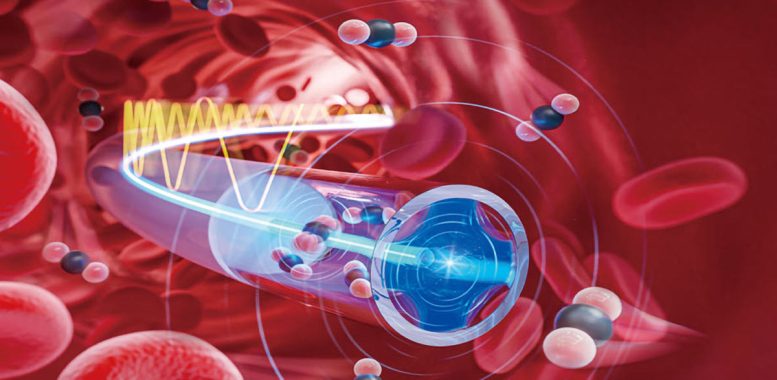
By International Society for Optics and Photonics December 24, 2024
Collected ât: https://scitechdaily.com/miniaturized-spectroscopy-delivers-real-time-monitoring-in-narrow-spaces/
The all-in-one optical fiber spectrometer offers a compact microscale design with performance on par with traditional laboratory-based systems.
Miniaturized spectroscopy systems capable of detecting trace concentrations at parts-per-billion (ppb) levels are critical for applications such as environmental monitoring, industrial process control, and biomedical diagnostics.
However, conventional bench-top spectroscopy systems are often too large, complex, and impractical for use in confined spaces. Traditional laser spectroscopy techniques rely on bulky components—including light sources, mirrors, detectors, and gas cells—to measure light absorption or scattering. This makes them unsuitable for minimally invasive applications, such as intravascular diagnostics, where compactness and precision are essential.
In a study published in Advanced Photonics, researchers from China unveiled a groundbreaking miniaturized all-fiber photoacoustic spectrometer (FPAS). This innovative device can detect trace gases at ppb levels and analyze nanoliter-scale samples with millisecond response times, making it particularly well-suited for continuous intravascular gas analysis.

“We attempted to address the significant challenge of shrinking the current photoacoustic spectrometer into a microscale size while preserving its high sensing performance, particularly for intravascular diagnosis and lithium battery health monitoring that require minimal invasiveness,” explains Professor Bai-Ou Guan from Jinan University, the corresponding author of the article.
Leveraging Photoacoustic Spectroscopy
While the current laser spectroscopy systems, mostly in open-path configurations, have an inherent scaling-down sensitivity with the device footprint, the proposed FPAS operates using photoacoustic spectroscopy (PAS), which detects sound waves generated by gas molecules when excited by modulated light.
Instead of using bulky resonant gas cell for acoustic amplification or large-size microphone for higher acoustic sensitivity as traditional PAS systems, the all-fiber photoacoustic spectrometer integrates a laser-patterned elastic membrane into a single optical fiber tip with a section of silica capillary to construct a microscale Fabry–Perot (F–P) cavity. The silica cavity acts as a sound-hard boundary, effectively confining and accumulating the acoustic waves generated by the gas molecules toward the flexible membrane. This local acoustic amplification compensates for the sensitivity loss caused by the reduction in the membrane diameter and results in a size-independent photoacoustic response.
In addition, both the pump and probe light beams are directly delivered through the same fiber for the excitation and detection of the photoacoustic signal, avoiding bulky free-space optics for the light delivery.
Compact and Powerful Design
With the F–P cavity measuring only 60 micrometers (1 µm = 10-6 m) in length and 125 µm in diameter, the system is remarkably compact. Despite its small size, it achieves a detection limit for acetylene gas as low as 9 ppb, which is almost as sensitive as larger, traditional laboratory spectrometers. The short cavity length also enables ultrafast measurements, with response times as quick as 18 milliseconds, which is 2 to 3 orders of magnitude faster than conventional photoacoustic spectroscopy systems.
Researchers successfully monitored real-time carbon dioxide (CO2) concentrations in flowing gas, detected fermentation in yeast solutions with sample volumes as small as 100 nanoliters, and tracked dissolved CO2 levels in rat blood vessels in vivo by inserting the FPAS into the tail vein via a syringe. “The spectrometer effectively measured CO2 levels under hypoxic (low oxygen) and hypercapnic (high CO2) conditions, highlighting its potential for real-time intravascular blood gas monitoring without the need for blood sample collection,” explains Associate Professor Jun Ma from Jinan University.
Moreover, the optical fiber can be easily connected to a low-cost distributed-feedback laser source and integrated with existing fiber-optic networks, making the system a cost-effective, compact, and flexible solution for spectroscopy.
With its small size, high sensitivity, and low sample volume requirement, the proposed miniaturized spectrometer delivers laboratory-level precision in a microscale probe format, with potential for such applications as continuous intravascular blood gas monitoring, minimally invasive health assessment of lithium-ion batteries, and remote detection of explosive gas leakage in extremely narrow spaces.
Reference: “Microscale fiber photoacoustic spectroscopy for in situ and real-time trace gas sensing” by Jun Ma, Enbo Fan, Haojie Liu, Yi Zhang, Cong Mai, Xin Li, Wei Jin and Bai-Ou Guan, 17 December 2024, Advanced Photonics.
DOI: 10.1117/1.AP.6.6.066008

Leave a Reply